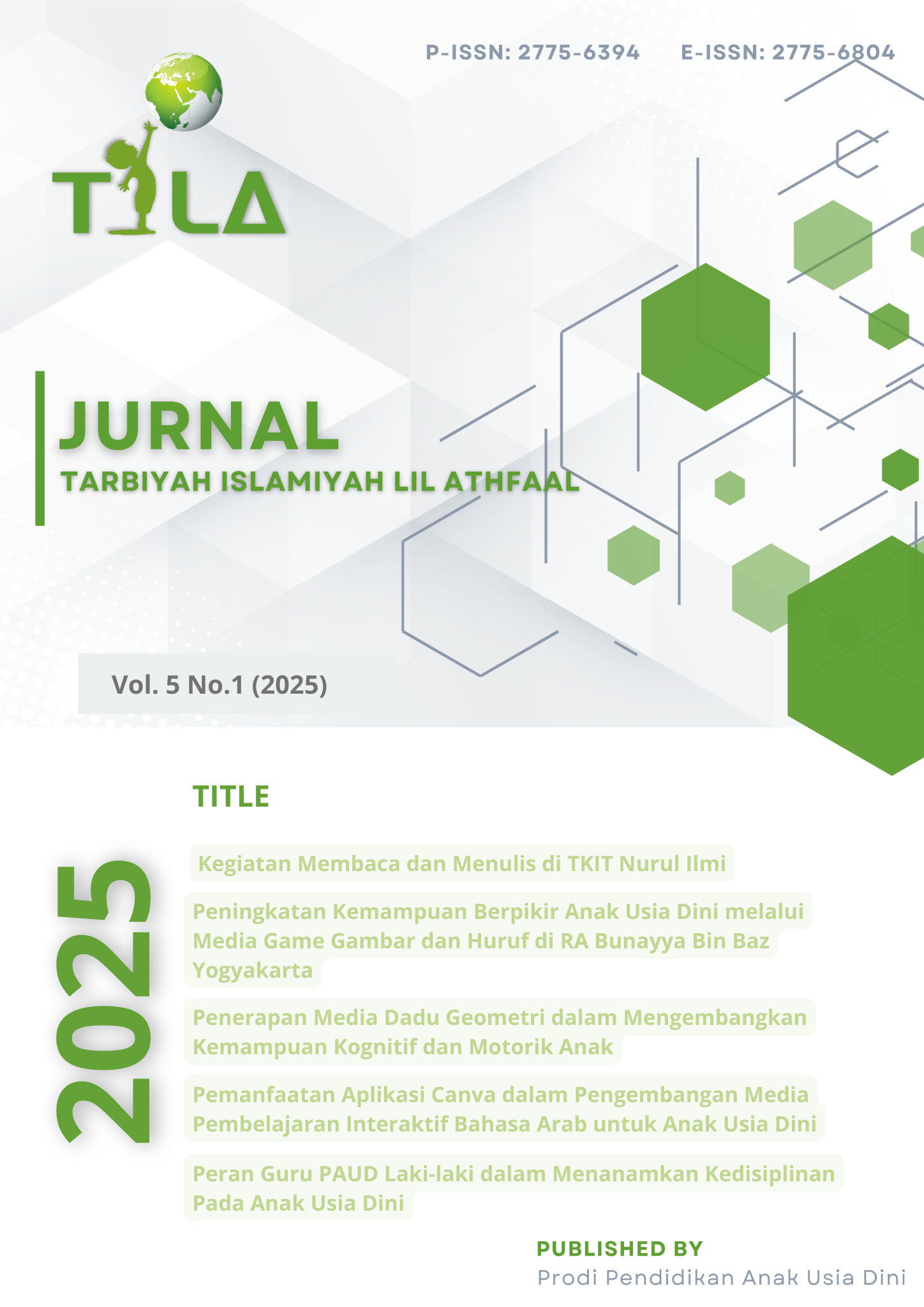Pemanfaatan Aplikasi Canva dalam Pengembangan Media Pembelajaran Interaktif Bahasa Arab untuk Anak Usia Dini Utilization of Canva Application in the Development of Arabic Interactive Learning Media for Early Childhood Section Articles
##plugins.themes.academic_pro.article.main##
Abstract
The digital age has brought significant changes in the development of learning media, especially for early childhood. Canva, with its ease of design and interactive features, offers great potential in creating innovative learning media. This article aims to explore the utilization of Canva in the development of Arabic interactive learning media for early childhood. Using a qualitative approach through in-depth interviews, observations, and questionnaires. This study aims to examine the effectiveness of Canva in creating learning materials that are interesting, relevant, and easily understood by early childhood. The results show that Canva is able to increase student engagement, motivate them to learn Arabic, and make it easier for teachers to design learning materials. This article also highlights the gaps in previous research, namely the lack of exploration of the use of Canva in the context of Arabic language learning and the need for media development that suits the characteristics of early childhood.
##plugins.themes.academic_pro.article.details##

This work is licensed under a Creative Commons Attribution-NonCommercial 4.0 International License.
References
-
Afianti, D. (2024). Penggunaan Aplikasi Canva dalam Proses Pembelajaran. EduTech Journal, 1(1), 9–16. https://doi.org/10.62872/mp5y5475
Azizah, W., Oktavia, N. A., & Mudinillah, A. (2022). The Use of The Canva Application in The Learning of Maharah Kitabah at The Islamic Boarding School Prof. Hamka Maninjau Class VII. Scientechno: Journal of Science and Technology, 1(1), 15–24. https://doi.org/10.55849/scientechno.v1i1.2
Creswell, J. W. (2014). Research Design: Qualitative, Quantitative, and Mixed Methods Approaches (4th ed.). Singapore: Sage Publications.
Fajriyani, W. S., & Hendra, F. (2024). Penggunaan Media Audiovisual Upaya Meningkatkan Hasil Belajar Siswa Mata Pelajaran Bahasa Arab di Tingkat Sekolah Dasar. Jurnal Pendidikan West Science, 2(02), 56–61. https://doi.org/10.58812/jpdws.v2i02.961
Gardner, H. (1993). Multiple Intelligences: The Theory and Practice. New York: Basic Books/Hachette Book Group.
Hariyastuti, A., & Triana, V. (2024). The effectiveness of using quizizz to improve the achievement of indonesian language learning outcomes on synonyms and antonyms material in grade 5 elementary school students. Jurnal Pendidikan Dasar Nusantara, 9(2), 182–195. https://doi.org/10.29407/jpdn.v9i2.21293
Ika, A., Ninta, S., & Hadi, M. S. (2023). Pemanfataan Aplikasi Canva Sebagai Media Pembelajaran Masa Kini dalam Kurikulum Merdeka The Use Of The Canva Application As A Contemporary Learning Media In The “Kurikulum Merdeka.” Jurnal Ilmu Pendidikan Islam, 1(3), 39–49. https://doi.org/https://doi.org/10.59059/al-tarbiyah.v1i3.284
Karim, N. A. (2024). Utilization of Quizizz as an Online Learning Media for Early Childhood. Raudhatul Athfal: Jurnal Pendidikan Islam Anak Usia Dini, 8(1), 57–69. https://doi.org/10.19109/ra.v8i1.23227
Kurniadi, A. M. (2024). Urgensi Pendidikan Bahasa Arab untuk Anak-Anak?: Investasi Cerdas untuk Masa Depan. Journal on Education, 06(04), 22916–22924.
Mayer, R. E. (2024). The Past, Present, and Future of the Cognitive Theory of Multimedia Learning. Educational Psychology Review, 36(1). https://doi.org/10.1007/s10648-023-09842-1
Mustafa, Alisa, N., & Pamessangi, A. A. (2023). Pengembangan Media Interaktif Digital Bahasa Arab Dengan Media Smart Apps Creator Kelas X di SMA Negeri 7 Luwu Timur Pendahuluan. Jurnal Sinestesia, 13(1), 252–260.
Nur Nasution, W., Halimah, S., & Mahrisa, R. (2023). The Influence of Canva Application Learning Media and Learning Motivation on Students’ Islamic Religious Education Learning Outcomes at Panca Budi Elementary School, Medan. International Journal of Research and Review, 10(2), 772–783. https://doi.org/10.52403/ijrr.20230292
Nurhayani, N., & Nurhafizah, N. (2022). Media dan Metode Pengembangan Literasi Anak Usia Dini di Kuttab Al Huffazh Payakumbuh. Jurnal Basicedu, 6(6), 9333–9343. https://doi.org/10.31004/basicedu.v6i6.3598
Pakpahan, F. H., & Saragih, M. (2022). Theory Of Cognitive Development By Jean Piaget. Journal of Applied Linguistics, 2(2), 55–60. https://doi.org/10.52622/joal.v2i2.79
Ryan, R. M., & Deci, E. L. (2020). Intrinsic and extrinsic motivation from a self-determination theory perspective: Definitions, theory, practices, and future directions. Contemporary Educational Psychology, 61(April), 101860. https://doi.org/10.1016/j.cedpsych.2020.101860
Saihu, M. (2022). The Urgency of Early Childhood Education In The Qur’an And Hadith And Its Relevance With Life In Modern Times. Jurnal AlifLam: Journal of Islamic Studies and Humanities, 3(1), 273–290. https://doi.org/10.51700/aliflam.v3i1.301
Setiadi, F. M., Maryati, S., & Mubharokkh, A. S. (2024). Analisis Dampak Penggunaan Gadget Terhadap Perkembangan Psikologis dan Keagamaan Anak Usia Dini (TK dan SD) dalam Perspektif Pendidikan Agama Islam. Muaddib: Islamic Education Journal, 7(1), 1–11. https://doi.org/https://doi.org/10.19109/muaddib.v7i1.24432
Setiadi, F. M., & Zulpina, Z. (2022). Pelatihan Penguatan Maharah Kalam Bagi Santri Pondok Pesantren Darut Tarbiyah Mandailing Natal. Jubaedah?: Jurnal Pengabdian Dan Edukasi Sekolah (Indonesian Journal of Community Services and School Education), 2(3), 319–326. https://doi.org/10.46306/jub.v2i3.98
Shatri, K., & Buza, K. (2017). The Use of Visualization in Teaching and Learning Process for Developing Critical Thinking of Students. European Journal of Social Sciences Education and Research, 9(1), 71. https://doi.org/10.26417/ejser.v9i1.p71-74
Widiastuti, D. E. (2024). The implementation of Canva as a digital learning tool in English learning at vocational school. English Learning Innovation (Englie), 5(2), 264–276. https://doi.org/https://doi.org/10.22219/englie.v5i2.34839

